Two Ways with Winter Squash
Recipes for Winter Squash Caponata and Pumpkin Panna Cotta; plus a third date added for the annual online Italian Christmas Cookies class!
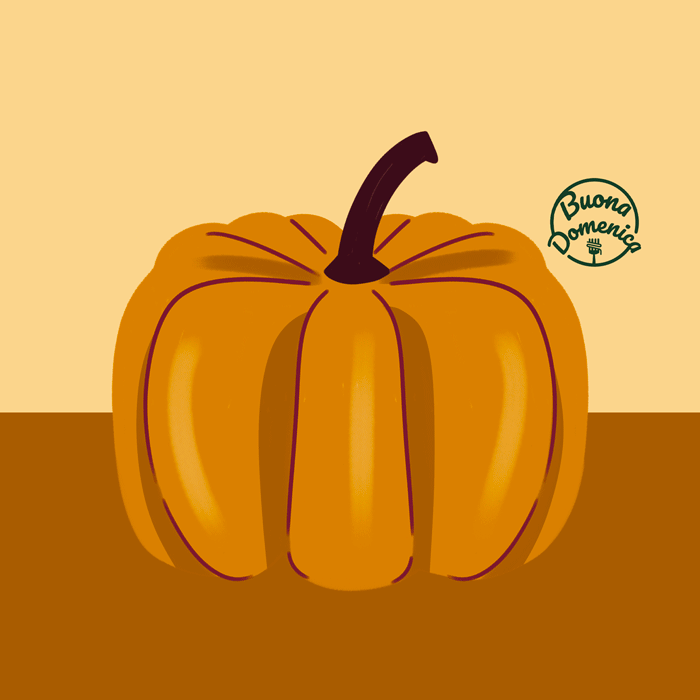
Benvenuti! Welcome to Buona Domenica, a weekly newsletter of inspired Italian home cooking. I’m a journalist, cooking instructor, occasional tour guide, and the author of eight cookbooks on Italian cuisine.
This week’s newsletter features two recipes: pumpkin panna cotta, for all subscribers; and winter squash caponata, a brand new recipe, for paid subscribers.
To catch up on past newsletters, visit the Buona Domenica Archive; for a complete list of all recipes published in this newsletter (122 and counting), check out the new Index of Recipes.
Good news, friends. I will not be gumming up your inbox or your brain with a daunting list of new Thanksgiving recipes to make. Last year, I published a full-on Thanksgiving with an Italian Accent newsletter, in which I shared a dozen recipes (more if you count all the links), everything from mushroom carpaccio and hard-boiled egg cicchetti to stuffed turkey breast, pumpkin-mascarpone pie, and coconut crème caramel.
And guess what: those recipes are just as enticing this year, so why cast them aside? I feel like Thanksgiving has become something of a competitive sport, with cooking websites, social media, and print publications continuously pelting us with recipes for the juiciest burnished turkey, the coziest retro sweet potato casserole, the smoothest mashed potatoes, the fluffiest rolls, and the flakiest pastry encasing the creamiest pumpkin pie topped with the most intricate lattice crust, so intricate it looks like it was stitched together with a crochet needle. Just now scrolling Instagram (I’m good at multi-tasking) I came across a post linking to “45 of the best Thanksgiving pie recipes” which made my head spin.
I get it; like everyone who loves to cook and eat, I am seduced by this endless parade of gorgeous, perfectly executed recipes. They all look so lush, and rich, and tempting. So much so that they’ve started to feel a bit empty, as though they were developed by AI.
This year, I’m dialing it back a bit. There will be just three of us at the table, so we will once again be making a stuffed turkey breast rather than the whole bird. The rest of the menu is TBD, but it will include the two recipes I’m sharing here. Both star winter squash, but in completely different ways. They are easy to pull off and can (and should) be made ahead of time, which is good because it frees up the kitchen on Thanksgiving Day, in case you are planning a big feast.
Caponata di Zucca, or winter squash caponata, is a seasonal riff on my mother’s classic eggplant caponata recipe, with meaty green olives, onion, celery, capers, and just the right amount of vinegar and sugar to give it that sweet-sour double flavor punch that makes your mouth water just a little whenever you think of it. This dish goes so well with simple roast turkey (or turkey breast) I wish I’d thought of putting it on the Thanksgiving rotation sooner. (Recipe behind the paywall.)
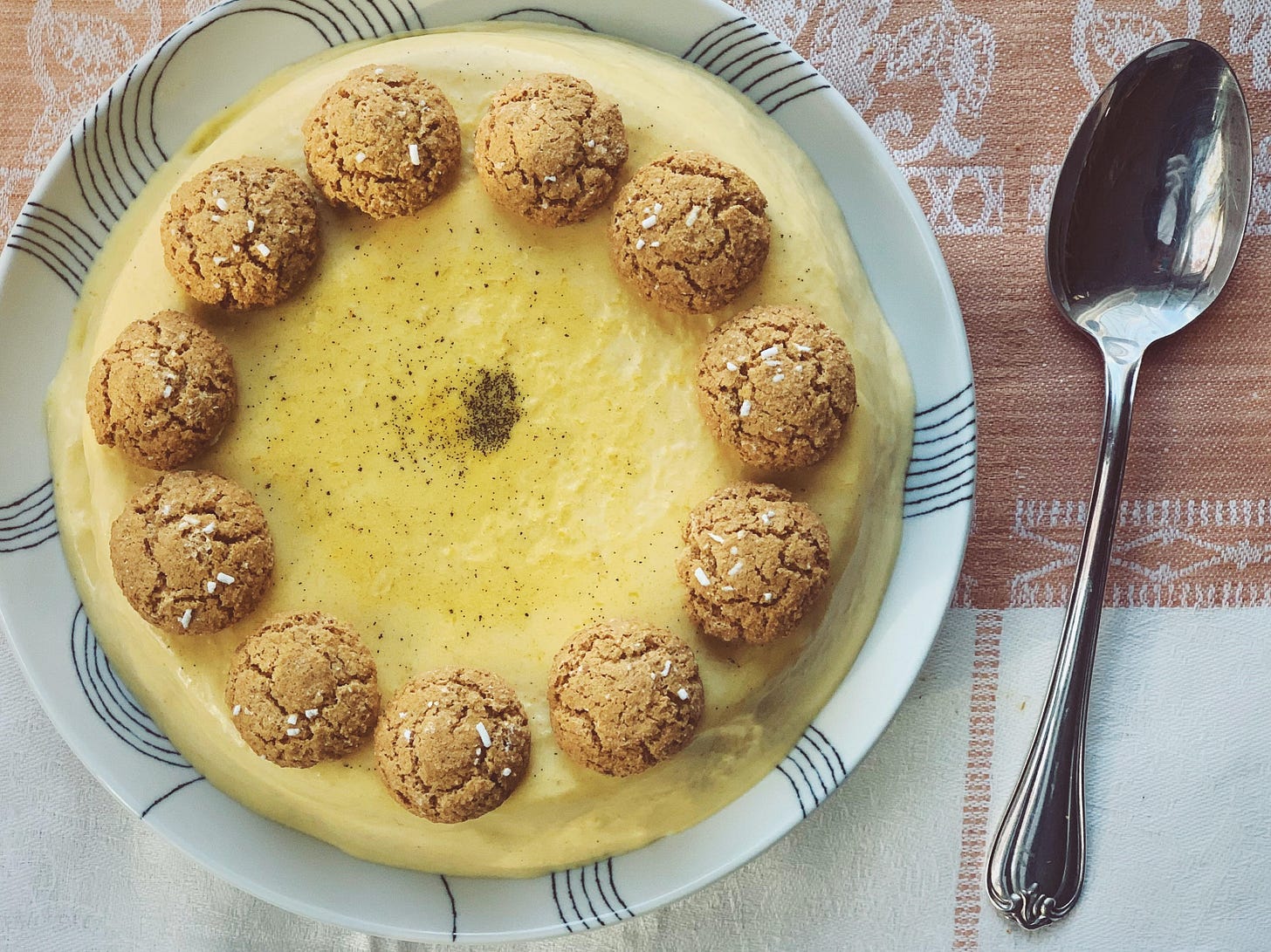
Pumpkin Panna Cotta is as delicate as the caponata is assertive. An optional garnish of amaretti cookies, whole or crumbled, adds a cheerful crunch. The recipe is from The Glorious Vegetables of Italy, which, incredibly, was published a decade ago. I mentioned this recipe in passing in last year’s newsletter, so thought it would be nice to share it this time around.
Obviously, you do not have to be celebrating Thanksgiving to make and enjoy these two recipes. They’re good dinner party dishes. The caponata goes beautifully with roast fish, roast pork, or sausages, among others; and the panna cotta goes with pretty much anything.
So: are you planning a big feast? Or a small gathering? Tell me what you’re making in the comments!)
A Word About Winter Squash
Why don’t I just call it pumpkin? Well, because while all pumpkins are winter squashes, not all winter squashes are pumpkins. And I tend to prefer non-pumpkin squashes, because there are varieties that are much sweeter and less fibrous than your typical cooking pumpkin. To slightly confuse matters, I’ve used the word ‘pumpkin’ in the panna cotta title even though I’m using winter squash that is not a pumpkin. For the alliteration, of course.
My favorite winter squashes are: Buttercup, Kabocha, and Red Kuri. Buttercup and Kabocha have hard green, ridged rinds, though Buttercup can also have an orange rind. The flesh of these squashes is dense, sweet, and smooth when puréed.
Other squashes I like include those pictured above: Butternut, the old standby, is readily available and easy to peel, and you often find it at the supermarket already peeled and cut into cubes. Carnival is a cross between acorn and sugar dumpling; its flesh, when cooked, is golden in color and smooth in texture. Black Futsu is a new-to-me favorite. Although the rind looks tough, it’s actually on the softer side and easy to cut into. The flesh is light orange in color, with a smooth texture and a flavor that brings to mind roasted chestnuts.
Here is a useful roundup of winter squashes from Simply Recipes if you’d like to know more.
UPTATE: NEW ITALIAN CHRISTMAS COOKIE CLASS DATE ADDED
Both dates for the online Christmas cookie class I posted about a couple of weeks ago sold out so quickly (within an hour of posting) that I have decided to add a third date: Sunday, Dec. 10 at 1 p.m. EST.
We will be making three types of cookies:
Biscotti al Cocco e Cioccolato Fondente: Chocolate-Dipped Coconut Biscotti (pictured above)
Biscotti di Frolla alla Nocciola: Hazelnut Shortbread Stars and Moons
Fig Jamaretti: Tender almond slices topped with fig jam and orange glaze
I’m veering just a bit from tradition with this year’s selection, but they are all very much Italian in spirit and in flavor.
All classes take place on Zoom. They are fun and informative. Space is limited (there are only 8 spots left). Click on the button below to register:
PAID SUBSCRIBERS: You are entitled to a 15% discount on the $70 class fee, bringing the fee down to $59.50. You’ll find the code at end of the newsletter, after the caponata recipe.
RECIPE: Pumpkin Panna Cotta
Roasted and puréed pumpkin or, more accurately, winter squash, gives classic panna cotta a soft golden hue and a delicate earthy sweetness. A few spoonfuls of mascarpone makes it extra creamy so that it lies somewhere between a true, wobbly panna cotta and a rich custard. Don’t skip the step of passing the squash purée through a fine-mesh sieve to remove any stringy fibers; it makes a difference.
You can chill the panna cotta in a mold or a bowl (I use a 1 1/2 qt soufflé dish), and then unmold it onto a serving plate, or you can simply spoon it out into dessert bowls. Or, chill it in individual servings (goblets make an impression!). The amaretti garnish is optional. I was reluctant to try it, as I thought the sharp almond flavor might drown out the much gentler notes of the pumpkin. But the two complement one another. You might be tempted, when you see the almost negligible amount of spice called for, to add several pinches more. Resist—we are not aiming for the aggressive Starbucks-y pumpkin spice aroma that has permeated every corner of autumn.
Makes 8 servings
INGREDIENTS
1 medium winter squash, 1 1/2 to 2 pounds (680 g to 910 g)
3 cups (720 ml) heavy cream
2/3 cup (130 g) sugar
1/2 vanilla bean
1/4 teaspoon ground cinnamon
A small grating of nutmeg, or a pinch of ground nutmeg
1 (1/4-ounce /7-g) envelope unflavored powdered gelatin
4 ounces (115 g) mascarpone cheese, at room temperature (optional; see NOTE)
INSTRUCTIONS
1. Heat the oven to 375° F (190° C).
2. Roast the squash: Use a large, sturdy chef’s knife to split the squash in half from top to bottom. Scoop out and discard the seeds (or reserve them for roasting and snacking on). Place the halves, cut-side down, on a parchment- or foil-lined rimmed baking sheet. Bake for 45 to 60 minutes, or until you can easily pierce through the rind into the flesh with a skewer or fork. Remove from the oven and let cool; then scoop out the flesh and discard the rind. Measure out 1 cup (250 g) and reserve the rest of the pulp for another use—like pumpkin-mascarpone pie.
3. Use a potato masher or an immersion blender to mash the cooked squash into a smooth purée. Force the purée through a fine-mesh sieve into a large mixing bowl. Cover and set aside.
4. Combine the cream and sugar in a medium, heavy-bottom saucepan. Scrape in the seeds from the vanilla bean half. Cook over medium heat, stirring often, until the sugar has dissolved, and the mixture is almost at a simmer, about 7 minutes. Remove from the heat and whisk in the cinnamon and nutmeg. Cover and let steep for 20 minutes.
5. Sprinkle the gelatin into a small bowl and pour 3 tablespoons cold water over it. Stir briefly, then let it stand for 5 minutes, until thickened. Uncover the cream mixture and reheat it until you see wisps of steam rising from the saucepan. Whisk in the gelatin, stirring until it is completely dissolved. Remove from the heat and let cool for 10 minutes.
6. Fold the mascarpone into the cooled squash purée until blended thoroughly. Slowly whisk the cream and gelatin mixture into the purée. Pour the mixture through a clean fine-mesh sieve into whichever vessel or vessels you plan to use to serve the panna cotta. Cover tightly with wrap and refrigerate until completely set, at least 3 hours and up to overnight.
7. If you plan to unmold the panna cotta, dip the bottom of the mold into a pan of hot water for 10 to 15 seconds. Run a thin knife or angled metal spatula along the inside rim of the mold. Place a serving plate upside-down on top of the mold and invert. You may have to give the bottom of the mold a few knocks or jostles to get the panna cotta to dislodge, but it should obey eventually.
8. To serve, arrange some amaretti on top of the panna cotta, or break them into pieces and sprinkle on top. Or skip the amaretti entirely and serve the panna cotta on its own.
NOTE: As I mentioned in the head note, adding mascarpone to the pumpkin cream and gelatin mixture gives the dessert a texture somewhere between a classic panna cotta wobble and a rich custard or pastry cream. If you prefer the more classic texture, leave out the mascarpone.
RECIPE: Winter Squash Caponata
My mother was not Sicilian, but she made excellent caponata, the classic sweet and sour version with fried eggplant cubes. She made another classic Sicilian dish, too: zucca in agrodolce, or sweet and sour pumpkin, the thin wedges of pumpkin—winter squash, really—fried in olive oil and seasoned with that same duo of vinegar and sugar, plus garlic and mint.
This dish essentially combines the two. It has everything—the autumn tones of olive and pumpkin, the gloss of the agrodolce sauce, the gentle crunch of barely-cooked onion and celery, the nose-tingling hit of vinegar and mint as you spoon a mound of it onto your plate. If you are looking to shake up your Thanksgiving side dish line up, this is a good contender.
For the squash, choose a variety with dense flesh that will stand up to frying—I love Kabocha, Buttercup, and Red Kuri for their sweetness and smooth texture, but reliable butternut also works well, especially as you can buy it already peeled and cut into chunks, in case you are not up for that somewhat tedious chore.
Makes 6 to 8 servings
INGREDIENTS
1 standard winter squash (2 lbs or 1 Kg), to yield 4 cups (20 oz/567 g) cubed
3 to 4 tablespoons (45-60 ml) extra-virgin olive oil or sunflower oil (or a mix of both, which is what I like)
Fine salt to taste
2 tablespoons (28 g) salt-packed capers
1 large yellow onion or sweet onion, such as Vidalia, sliced through the stem end and cut into thin wedges
6 ounces (170 g) celery, including some leaves if you have them, cut crosswise into slices to yield 1 1/2 to 2 cups
Pinch of peperoncino (optional)
2/3 cup to 1 cup (160 to 240 ml) tomato sauce
2 cups green olives, pitted (about 240 g after pitting) and cut in half or quartered if large
3 tablespoons sugar
4 tablespoons white wine vinegar
2 tablespoons white balsamic vinegar (or substitute cider vinegar or more white wine vinegar)
A small handful of fresh mint leaves, plus a small sprig for garnish.
INSTRUCTIONS
1. Fry the squash in batches: Heat the oil in a large skillet or wide, heavy-bottomed saucepan over medium to medium-high heat until it shimmers. Carefully drop in 1/3 to 1/2 of the squash cubes without crowding the pan. Cook, letting them brown on the bottom for a couple of minutes, before nudging them around so that they brown (more or less) on all sides. You want a nice golden-brown “crust” with a couple of darker spots here and there. They should be done in about 8 minutes. Transfer them to a paper towel-lined plate. Brown the remaining squash in the same way and transfer them to the plate as well. Sprinkle lightly with salt and set aside.
2. Place the capers in a small bowl and cover with water. Stir briefly and set them aside.
3. Add another tablespoon or so of olive oil to the pan if needed and tip in the sliced onion. Cook over medium heat for about 5 minutes, until the onion is barely beginning to soften and brown slightly at the edges. Stir in the celery and peperoncino and sauté for about 3 minutes, until the celery, too, is just starting to soften.
3. Stir in 2/3 cup (160 ml) tomato sauce and bring to a simmer. If the amount of tomato sauce seems scant, add another 1/3 cup (80 ml). Lower the heat and simmer for 5 minutes. Drain the capers and add them to the pan, along with the olives. Stir in the sugar and the vinegars and simmer for 2 to 3 minutes longer to dissolve the sugar. Scatter in the reserved fried squash and stir gently to coat with the sauce. Taste and adjust the seasoning with more salt or sugar, if needed. Cook just until the squash pieces are heated through and tender but hold their shape—everything in the pan should still have texture, with no mushiness. Remove from the heat and tear the mint leaves into the pan, then stir them in. Let cool to room temperature before serving.
4. The caponata will keep in the refrigerator for several days, and indeed it is better if you let it rest overnight before serving. To serve, remove it from the fridge and let it come to room temperature. Gently toss to re-distribute the sauce, then spoon into a serving dish. Top with a sprig of fresh mint.
CLASS DISCOUNT CODE: For those paid subscribers who are interested in registering for the Italian Christmas Cookies Class taking place on Nov. 10, the 15% discount code is: COOKIES4YOU. PLEASE NOTE that I put an incorrect code at the top of your email and discregard that one. Enter the code COOKIES4YOU when prompted at checkout to receive the discount ($10.50 off the $70 price).




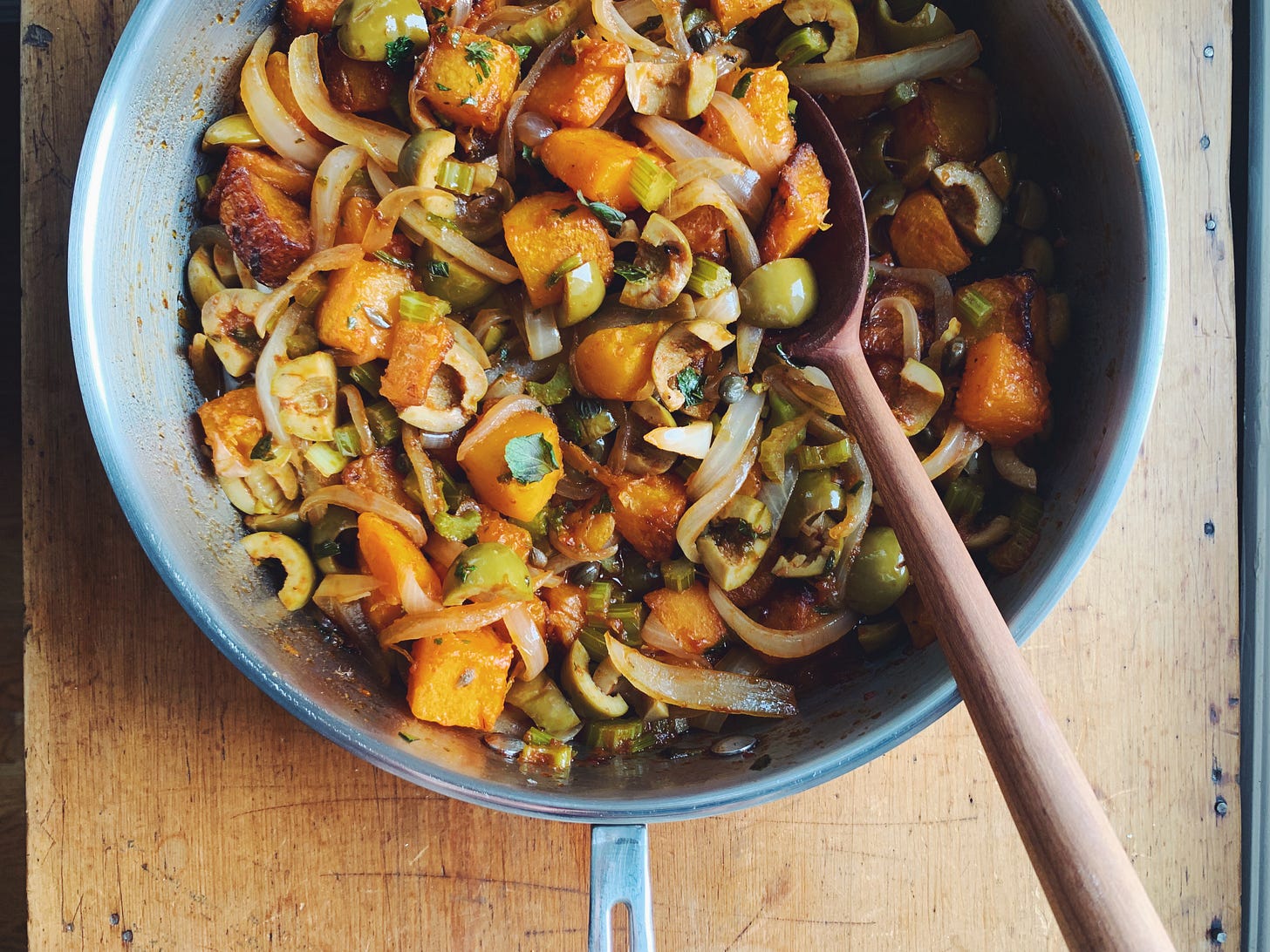
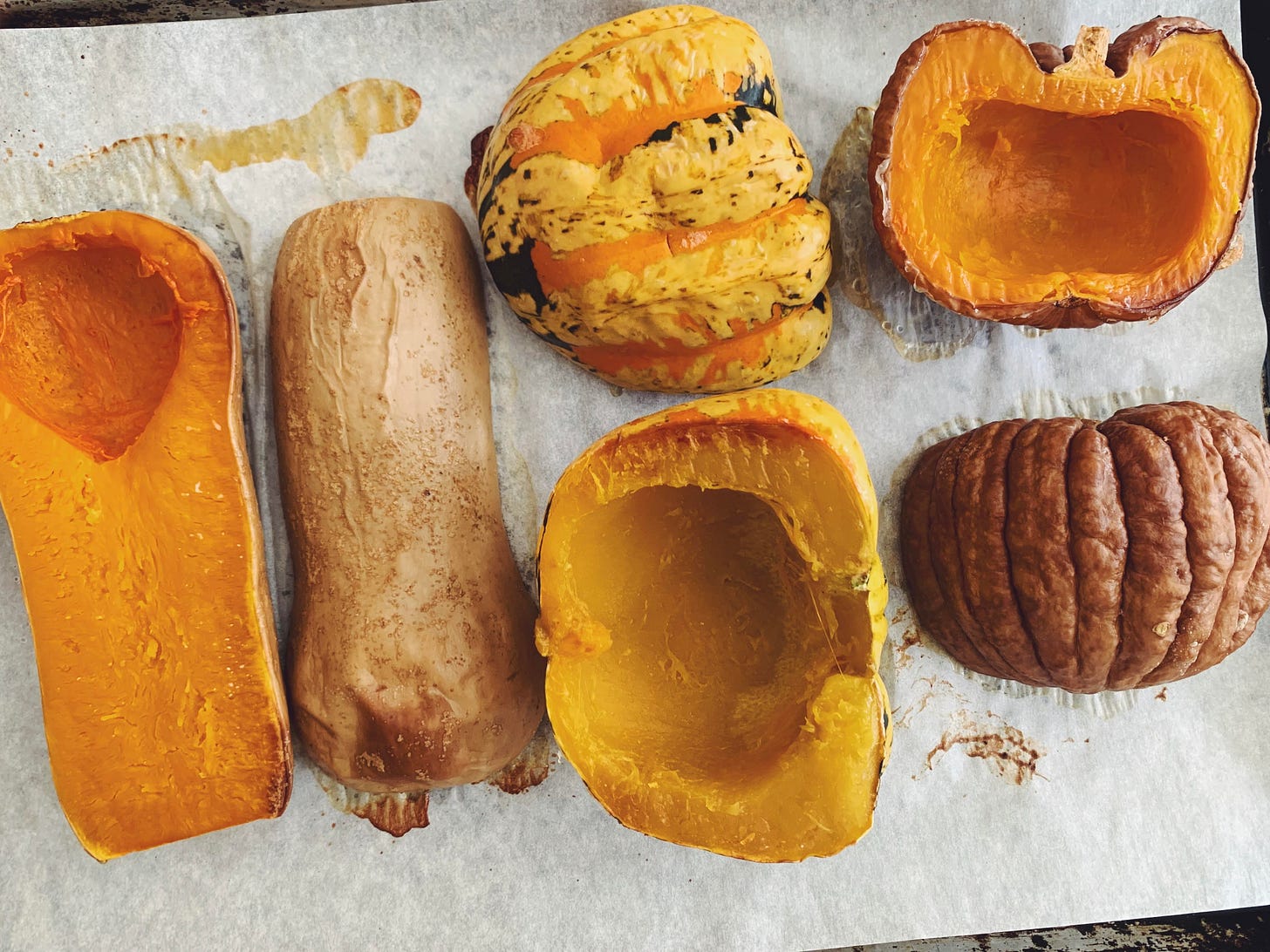
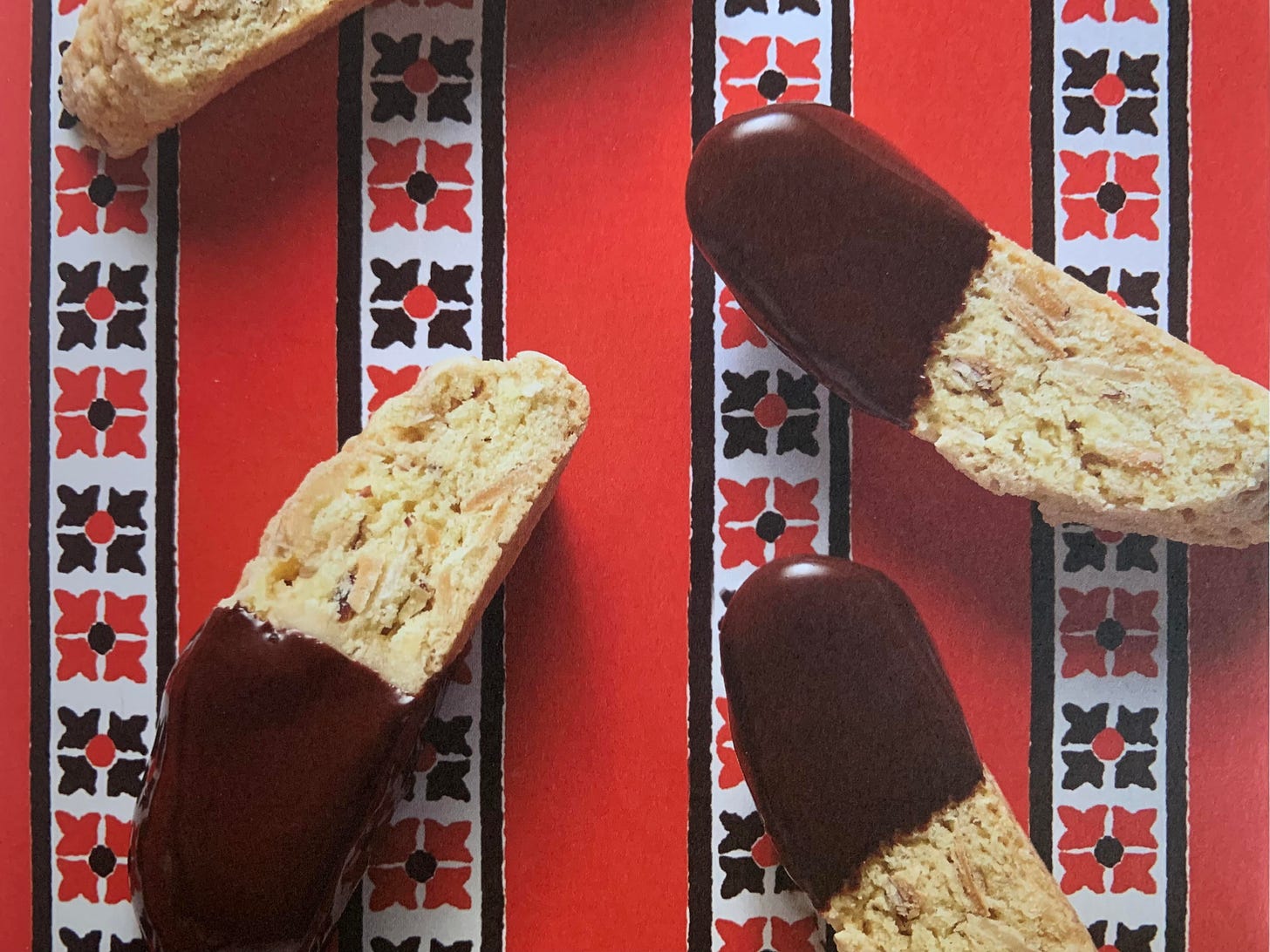


Pumpkin Panna Cotta with a crown of amaretti biscuits, stop it!! 😋 beautiful and delicious post as always, Domenica.
Your Winter Squash Caponata looks to be an absolutely brilliant combination.
I'm planning o have my first go at it this week.
Have you been making this conjunction of two traditional, family recipes for a while, or is this a fairly new creation of yours?
Happy Holidays Domenica - and thank you. You've been making my holidays brighter, and tastier, for many years now.